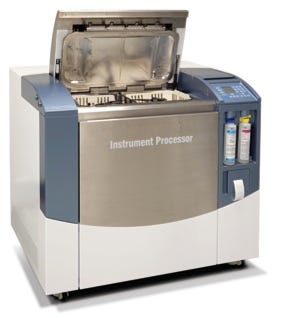Is This the Answer to the Superbug Scare?
July 21, 2015
Health providers are showing interest in a dishwasher-like device amid superbug deaths related to a tough-to-clean endoscope.
|
The LIC machine (Image courtesy of Proven Process Medical Devices) More Stories:Why Duodenoscope Infections Could Affect Entire MedtechFDA Panel Deems Duodenoscopes to Be UnsafeDOJ Is Investigating Olympus Duodenoscopes |
Chris Newmarker
UCLA's Ronald Reagan Medical Center plans to install Langford IC Systems' "LIC" machine to clean endoscopes in the aftermath of a deadly superbug outbreak, according to a recent announcement from Proven Process Medical Devices, which helped Langford engineer and test the device.
The LIC uses no connectors, and does not push water and disinfectants through the endoscopes in a garden hose-like, one-way flow like other endoscope cleaning devices, according to Proven Process (Mansfield, MA). Instead, the LIC's patented technology creates a fluid dynamic that pushes and pulls fluid at fierce velocity. Water and disinfectants reverse directions thousands of times through the scope and its channels, creating a powerful scrubbing action on all of the endoscope's surfaces, corners and crevices.
"There was a lot of effort to perfect the fluid mechanics and the treatment of the waste so it could be discarded into our everyday sewer system. There was an enormous amount of testing to validate this cleaning process as there are hundreds of scope configurations to test," Kenneth Fine, Proven Process' president, explained in an email to Qmed.
Langford IC Systems (Canton, MA) has actually had FDA clearance since 2011, but the company's founder and owner Terry Langford tells the Boston Business Journal that there wasn't much of a market because manual cleaning seemed to be working fine for hospitals.
That all changed after at least seven patients were infected and two died from a drug-resistant superbug at UCLA's Ronald Reagan Medical Center between October 2014 and January 2015. The CRE exposures were linked to a contaminated, reprocessed Olympus duodenoscope, a special type of endoscope used in more than 500,000 procedures annually in the U.S.
Another 11 CRE-related patient deaths have been linked to duodenoscope procedures at Virginia Mason Medical Center in Seattle between 2012 and 2014.
"Unfortunate circumstances have led to the further investigation of the cleaning processes for scopes," Fine said. "We hope our machine can alleviate the risks and remove the worry patients might have as they undergo procedures."
Sold in the United States by manufacturers including Fujifilm, Olympus, and Pentax, duodenoscopes are threaded down through the digestive tract and into the small intestine. They provide the least invasive way of draining fluids from pancreatic and biliary ducts blocked by cancerous tumors, gallstones, or other conditions. But the duodenoscopes' movable "elevator" mechanism at the tip, while improving efficiency and effectiveness, are challenging to disinfect, according to FDA.
Olympus is now facing a slew of lawsuits, and the U.S. Justice Department has been investigating.
An FDA advisory panel in June recommended drastically improving cleaning techniques for duodenoscopes linked to the superbug outbreaks. While it is not bound to, FDA generally follows the advice of such panels.
Proven Process notes that FDA has a new standard that requires duodenoscope cleaning to eliminate all but 6.4 mcg of protein per square centimeter. On top of that, FDA has changed the inoculum used in the testing to the tougher to clean British soil, versus the previously used ATS.
Proven Process claims that some makers of automated endoscopic reprocessors have conceded that they can't meet the new standard for now, but the LIC machine has no trouble cleaning to that level. In fact, the Langford machine reduces leftover residue to an average of 2.5 mcg/cm2, and in some cases lower than 1 mcg/cm2.
UCLA will receive its new LIC machine as soon as the necessary utilities are installed, and commercialization is imminent. Langford tells the Boston Business Journal that the market is waiting for a third-party valuation to further prove what the LIC machine is able to do.
Fine sees the LIC machine's story as a lesson in perseverance, as well as listening to the market consistently as it transforms. "The technology was developed and it changed the paradigm as to how devices were being cleaned for re-use. The market didn't believe it needed a new technology to upgrade the cleaning processes."
Refresh your medical device industry knowledge at MEDevice San Diego, September 1-2, 2015. |
Chris Newmarker is senior editor of Qmed and MPMN. Follow him on Twitter at @newmarker.
Like what you're reading? Subscribe to our daily e-newsletter.
About the Author(s)
You May Also Like


